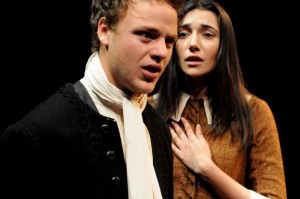
You’re probably already familiar with “The Crucible”. The play, written in 1953 by Arthur Miller, is his most frequently produced work worldwide and a commonly read text in high school literature classes. Even if you’re already familiar with the play, it’s definitely worth coming out to see the Stanford Theater & Performance Studies (TAPS) production, which provides some interesting fresh takes on the play. For those unfamiliar with the story, “The Crucible” is a dramatization of the 17th-century Salem Witch Trials; it also serves as an allegory for the House Un-American Activities Committee anti-communist investigations that were taking place at the time Miller wrote they play and under which he was questioned. Although the connections between the two events are clear, the story is easy to understand even without any context.
Put on in conjunction with Stephen Karam’s “Speech and Debate,” which ran earlier this quarter, the production features not just student actors but also student dramaturges and designers. Together with the TAPS faculty and Bay Area professionals, they create a winning show. The production does an excellent job of drawing the audience into the story and creating tension.
The cast is excellent all around, with particularly standout performances from David Raymond ‘14 and Safiya Nygaard ‘14, who portray the lead characters John Proctor and Abigail Williams, the primary accuser. Also noteworthy are Anneka Kumli ‘13 as Elizabeth Proctor and Jessica Waldman ‘15 as Mary Warren, another of the accusing girls. The time and research that the actors put into their characters is evident, and the realistic portrayals go a long way toward drawing the audience into the scene. At times, the audience became so frustrated by the characters’ actions that they actually audibly groaned.
The performances are accentuated by the well-done production design. The show uses various hymns and songs between acts. Singing was also featured at the opening and close of the show. The use of music is very well thought out, and the carefully chosen hymns add greatly to the production. The movement and music used in the opening of the play, one of the highlights of the show, is extremely well executed and effectively sets the scene for the rest of the show. The set, a cabin-like room with two stories, is cleverly used to stand for multiple locations, indoors and outdoors.
Of course, the show has some flaws. Sometimes, especially during the court scenes, the performances can get a bit dramatic, and the dialogue can carry the actors away. Some of the smaller touches added, such as having Abigail moving on and offstage during the first act, felt out of place and of questionable significance. At times, the blocking of the actors felt overly choreographed and false. However, most of these flaws were very minor and didn’t detract much from the overall high quality of the production.
If you haven’t seen it yet, “The Crucible” will be playing on March 8 and 9 at 8 p.m. in Pigott Theater.